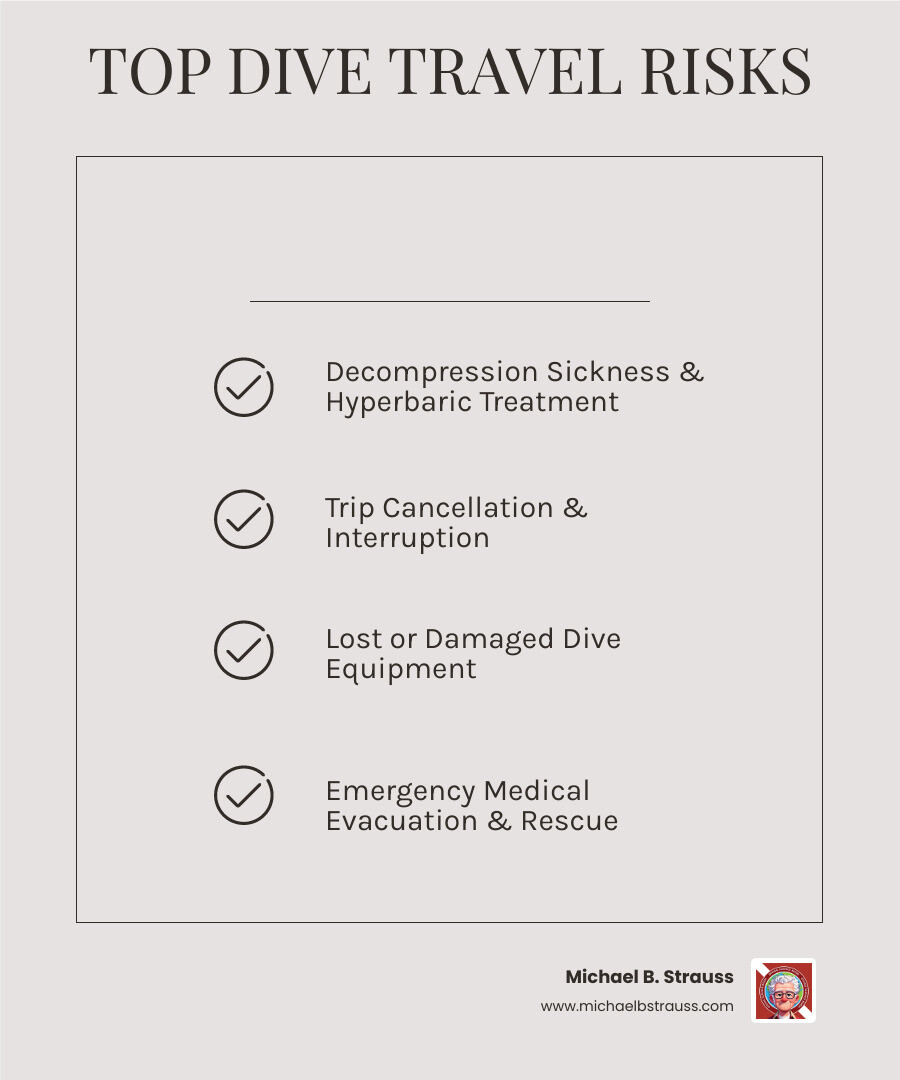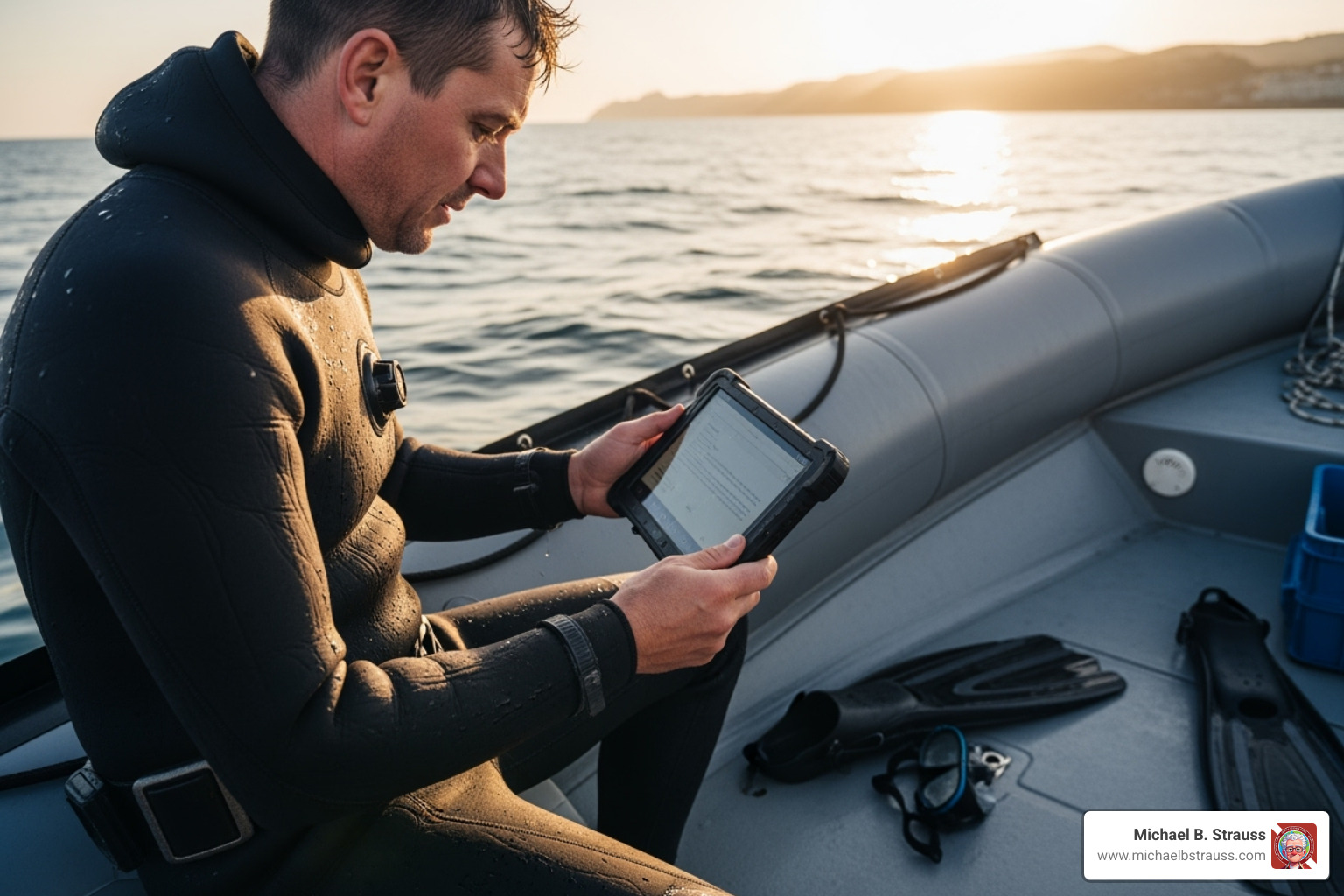Why Your Next Dive Trip Needs Specialized Insurance
Single trip dive insurance offers specialized coverage for scuba diving adventures, filling crucial gaps that standard travel insurance policies often leave open. Planning a dive trip comes with unique risks, and as one dive operator notes, "Finding a suitable travel insurance policy to cover any trip is not an easy task. The challenge is even bigger when going on a dive trip."
Standard travel insurance frequently excludes scuba diving or limits coverage to shallow depths, leaving you unprotected. Specialized dive insurance is designed to cover key risks, including:
- Emergency medical expenses and hyperbaric treatments
- Emergency evacuation and repatriation
- Trip cancellation and interruption
- Lost or damaged diving equipment
- Search and rescue operations
Medical expenses from diving accidents can be substantial, and emergency evacuations from remote locations can be even more costly. Whether you're exploring the Maldives or Mexico's cenotes, the right insurance protects your health and financial investment, providing essential peace of mind.

Understanding Your Single Trip Dive Insurance Options
Picture this: you're planning the dive trip of a lifetime to explore pristine coral reefs in a remote location. While you're busy researching the best dive sites and packing your gear, there's one crucial element that deserves just as much attention – your single trip dive insurance. Think of it as your most important dive buddy, one that stays with you from the moment you leave home until you return safely.
What's Covered? Key Inclusions in a Policy
Quality single trip dive insurance provides comprehensive coverage that understands the unique risks of scuba diving. Key inclusions to look for in a policy include:
Emergency Medical Expenses: This covers hospital bills, doctor's fees, and prescriptions for any medical emergency during your trip, including dive-related incidents.
Hyperbaric Chamber Treatments: This is a critical component often excluded by standard insurance. In cases of decompression sickness, hyperbaric oxygen therapy can be life-saving. As Dr. Michael B. Strauss notes in his work on diving safety, understanding conditions like decompression sickness is vital for diver well-being.
More info about Decompression Sickness

Emergency Medical Evacuation and Repatriation: This coverage is a lifeline in remote locations, covering the high cost of air ambulances to get you to a suitable medical facility. It also handles your safe return home in case of severe injury or illness.
Trip Cancellation and Interruption: This protects your financial investment if a sudden illness, family emergency, or severe weather forces you to cancel or cut short your trip.
Lost or Damaged Diving Gear: This covers the replacement costs for your valuable equipment if it's lost, stolen, or damaged during your travels.
Primary vs. Secondary Coverage: Look for primary coverage, which pays claims directly without requiring you to go through your regular health insurance first. This is crucial for dive-specific treatments that standard plans may not cover.
Personal Liability and Search & Rescue: These protections cover accidental injury to others or property damage, and assist with the costs of a search operation if you go missing on a dive.
Standard Travel vs. Specialized Dive Insurance: What's the Difference?
Many divers mistakenly believe their standard travel insurance will cover their scuba adventures. Unfortunately, most general policies have significant limitations and exclusions related to diving.
Standard policies often include hazardous activity exclusions that either completely deny coverage for scuba diving or impose strict depth limits (e.g., 10 meters/33 feet). Furthermore, they rarely provide adequate hyperbaric treatment coverage, which is essential for treating decompression sickness. Dive equipment coverage is also typically insufficient, lumping expensive gear under general baggage with low limits.
Specialized dive insurance is designed to fill these critical gaps. The table below highlights the key differences:
| Feature | Standard Travel Insurance | Specialized Single Trip Dive Insurance |
|---|---|---|
| Depth Limits | Often excluded or limited to shallow depths (10m/33ft) | Covers depths up to certification level, some offer no depth limits |
| Hyperbaric Chamber Coverage | Rarely included or very low limits | Explicitly included with high coverage limits |
| Dive Equipment Protection | Limited general baggage coverage | Higher limits specifically for dive gear |
| Emergency Evacuation | May not cover specialized dive-related evacuations | Comprehensive coverage including remote dive locations |
| Primary Coverage | Often secondary to other health insurance | Frequently offers primary coverage for immediate payment |
| Trip Interruption | Covers general travel interruptions | May include dive-specific interruptions |
The integrated approach of single trip dive insurance ensures you have seamless protection covering both common travel mishaps and the unique risks of diving, offering comprehensive peace of mind in a single policy.
Factors That Influence the Cost of Single Trip Dive Insurance
Several factors determine the cost of your single trip dive insurance. Understanding them helps you balance comprehensive coverage with your budget.
- Trip Duration: Longer trips mean more time exposed to risks, resulting in higher premiums.
- Destination: Remote locations with limited or expensive medical care will increase the cost of insurance.

- Your Age: As with most insurance, premiums may be higher for older travelers due to increased health risks.
- Total Trip Cost: If your policy includes trip cancellation, a more expensive trip will cost more to insure.
- Coverage Limits: Higher maximum payouts for medical care, evacuation, or equipment loss will increase the premium.
- Deductibles: Choosing a higher deductible (the amount you pay out-of-pocket) can lower your premium.
While pricing varies, the cost of dive insurance is typically a small fraction of your total trip investment, making it a worthwhile expense for protecting your health and budget.
Navigating Exclusions and Limitations
Even the best single trip dive insurance has exclusions. Understanding these limitations before you buy is crucial to avoid surprises. Common exclusions include:
- Depth and Gas Mix Limits: Ensure your policy covers the depths and gas mixes (like nitrox or trimix) you plan to use, especially for technical diving.
- Certification Requirements: Your coverage is only valid if you are properly certified for the type of diving you are doing. Diving beyond your training can void your policy.
- Pre-existing Medical Conditions: You must disclose all pre-existing conditions. Failure to do so can lead to denied claims. Dr. Michael B. Strauss's research on diving medical problems highlights the importance of understanding your health in relation to diving.
More info about diving medical problems
- Age Restrictions: Some policies have upper age limits for purchase, so verify this before you book.
- Professional Diving: Recreational policies do not cover professional activities like instructing or guiding, which require separate liability insurance.
- Geographic Exclusions: Coverage may not apply in countries with active government travel advisories.
- Unsafe Practices: Diving under the influence of drugs or alcohol, or otherwise ignoring safe diving practices, will likely invalidate your coverage.
Always read the policy details carefully to ensure you are fully protected for your planned adventure.
Securing and Using Your Dive Insurance
Getting your single trip dive insurance sorted doesn't need to feel like navigating a complicated underwater cave system. Think of it more like planning a relaxed reef dive - with the right preparation and knowledge, everything flows smoothly, leaving you free to focus on the incredible adventures ahead.
The Purchase and Claims Process Explained
Securing and using single trip dive insurance is a straightforward process.
Purchasing Your Policy
Buying dive insurance is typically a simple online process. You can get quotes, compare plans, and purchase coverage in minutes. After paying securely, you'll receive your policy documents by email. It's crucial to download these documents and save the 24/7 emergency contact number where you can easily access it, both online and offline.
Making a Claim
If an incident occurs, follow these steps:
- Contact your insurer immediately. Their 24/7 emergency assistance line is your first call. They can guide you, arrange medical care, and may even pay facilities directly.
- Document everything. Keep all receipts for medical treatment, transportation, and replacement gear. For accidents, gather detailed accounts, dive logs, and witness statements. For lost or stolen items, file a police or operator report.
- Submit your claim. Most providers have online portals for submitting claims and all your supporting documentation. Thorough records will help ensure a smooth and speedy process.

Choosing the Right Single Trip Dive Insurance for Your Adventure
Selecting the right single trip dive insurance requires matching the policy to your specific plans. A casual reef diver has different needs than a technical wreck diver.
First, assess your planned activities. Consider your maximum depth, any special activities like wreck or night diving, and whether you'll be on a remote liveaboard. Your policy must align with your certification level and planned dives. Also, check if the coverage for dive gear is adequate for the equipment you're bringing.
Next, dive deep into the policy details. Don't just look at the coverage limits; read the fine print on exclusions, pre-existing condition clauses, and geographic restrictions. Choosing a provider that specializes in diving is also beneficial, as their expertise in dive medicine and logistics can be invaluable during an emergency.
Your Final Pre-Purchase Checklist
Before you buy, run through these final checks:
- Confirm depth and activity coverage matches your planned dives.
- Verify medical and evacuation limits are sufficient for your destination.
- Read the pre-existing condition clause and disclose everything accurately.
- Save the 24/7 emergency contact number and share it with a buddy.
As Dr. Michael B. Strauss emphasizes in his diving safety resources, knowledge and preparation are a diver's best defense. A good insurance policy is the crucial safety net for when the unexpected occurs. By carefully selecting your single trip dive insurance, you invest in peace of mind, allowing you to focus on the adventure ahead.
Explore our diving safety resources
Get your copy of Diving Science Revisited here: https://www.bestpub.com/view-all-products/product/diving-science-revisited/category_pathway-48.html
DISCLAIMER: Articles are for "EDUCATIONAL PURPOSES ONLY", not to be considered advice or recommendations.






